Madame Pele’s story: Island’s most revered goddess, passed through generations, runs as deep as her lava
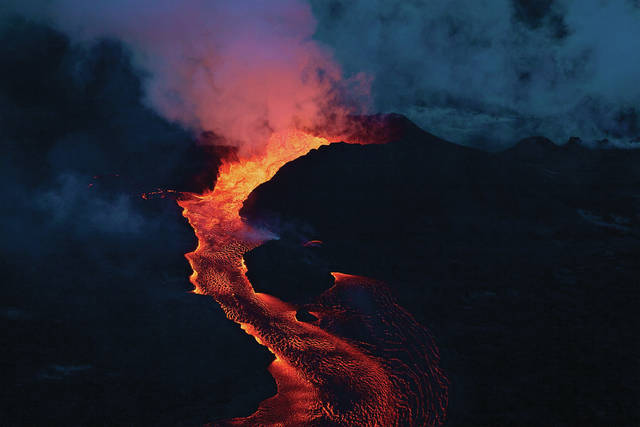
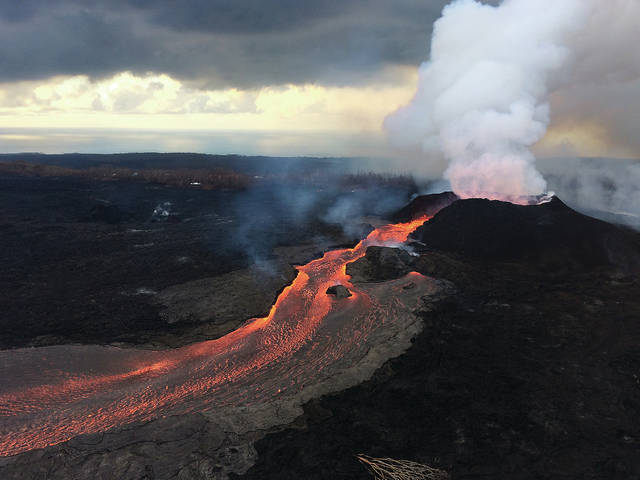
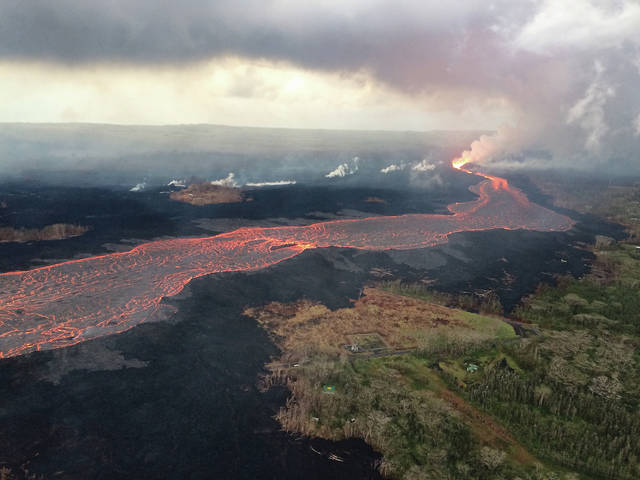
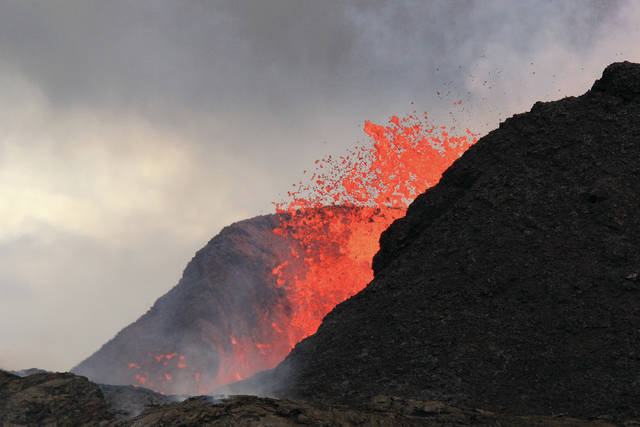
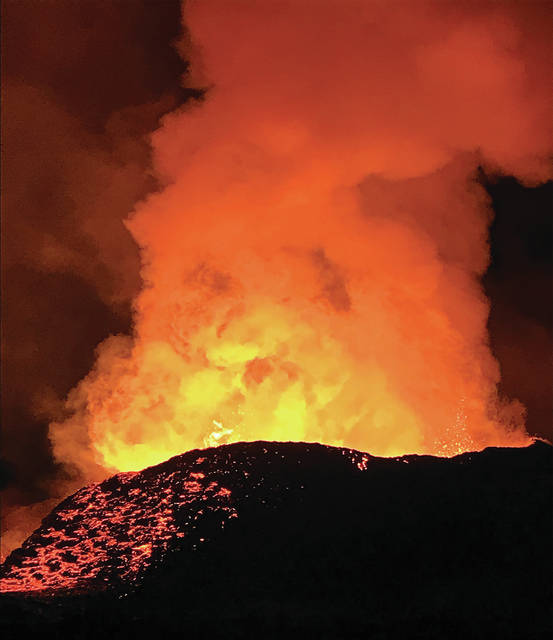
KAILUA-KONA — She is creator. She is destroyer.
KAILUA-KONA — She is creator. She is destroyer.
She is Madame Pele, Hawaiian fire and volcano goddess.
Her home is in Halema‘uma‘u, atop Kilauea volcano. But, right now, she is traveling through lower Puna.
Her name has come up frequently in the last month amid the ongoing eruption in Kilauea’s lower East Rift Zone that has sent rivers of lava down the volcano’s flanks to the coast, wiping entire subdivisions off the map while covering nearly 10 square miles.
But, really, who is Madame Pele?
Her legend has been perpetuated from generation to generation through chants by kumu dedicated to keeping her story alive.
“Chants come to us from the time of antiquity and someone observed and created the chant and passed it down,” said Hawaii Community College instructor Leialoha Kaleimamahu, who is from Kaimu in Puna. “The function of Pele is to establish land for all of us and the creatures who live on the land.”
Those mo‘olelo — or oral stories, tales, myths, chronicles and legends — are like any story told over and over again: they get juicier over time. Every time the story of Pele was told, it got more magical. So, Pele must have done something great, because the story is still perpetuated today.
Madame Pele’s coming to Kilauea
There are many versions of how Pele came to Hawaii.
“In one of several stories, it is said that Pele falls in love with her sister Namakaokaha‘i’s significant other. In another story, Pele kills the significant other,” explained Kumu Keala Ching, a Hawaiian cultural educator, composer, songwriter, and spiritual advisor to many Hawaiian organizations.
Because of the conflict, Pele’s elders instruct her to leave Kahiki, the ancestral land.
“So, Pele leaves, along with her siblings. She travels with about seven Hi‘iaka sisters along with her brother, Kamohoali’i, the shark god,” said Ching.
Kamohoali’i guides the canoe to Hawaii, stopping first at an island called Nihoa, north of Ni‘ihau.
There, Pele digs her o‘o stick, called paao, into the earth in search of fire.
Flames rise from the ground. But the moisture in the air, which was her scorned sister, Namakaokaha‘i, quenches the fire.
So, Pele continued her search, traveling south through the archipelago of Hawaii, digging her o‘o on each island. But, each time, Namakaokaha‘i continued to kill the fire.
Then, when she got to Kilauea, on Moku o Keawe (Hawaii Island), the moisture was unable to extinguish the fire because she was far from the ocean.
Pele made Halema‘uma‘u her new home. But, it’s said, she would travel back to Maui, still in human form.
It was on the Hana Coast that Pele again met her sister, Namakaokaha‘i. The enraged sister is said to have torn Pele’s body apart, furious that she was still alive.
But when Namakaokaha‘i ripped apart Pele’s bones and put them in a hill called pu‘uiwiopele, the clouds over Kilauea became ablaze with a red glow.
Seeing the redness in the cloud, Namakaokaha‘i knew then that her sister had become the lava goddess. Pele was transformed into deity form, residing in her new home, Halema‘uma‘u crater.
How Madame Pele comes to us
Though Pele is now in deity form, there are many stories of people seeing her as an old woman with flowing reddish-gray hair or a beautiful, young woman wearing a red and black mu‘umu‘u, especially when the lava is flowing.
“She’s the goddess of the fire, so, in our minds, we come up with human likeness. That’s what our minds can bridge. We see a female who looks like you and I,” said Kaleimamahu.
The most common story is of Pele hitchhiking. It’s said Pele will get in a car and ask for a cigarette. After lighting it with the tip of her finger, Pele then disappears. Those who pick her up and show her kindness are spared from danger ahead.
In another story, Pele comes to a house with her white dog asking for food or drink. When she is given something freely she leaves instructions for the occupants. Most of the times instructions were to put ti leaf around their house, ti leaf in the four corners, clean up their house and open their doors so that she would know that this is the house to spare. But if she is refused kindness, lava overtakes the home.
It’s also said that Pele can be seen in lava, and the type and speed of the flow can be indicative of her age.
For example, Ching related, when you look at the lava that is currently going into Kapoho Bay, the flow looks very young and is moving very quickly. In that reference, Pele is a young woman. Compare that to the thicker, or more viscous, lava that broke ground in early May in Leilani Estates, which is said to be the older version of Pele.
Legend of offering gin
With the belief that Pele can morph from goddess to human form, it has been said that her favorite drink is gin, and offering her that spirit will appease the goddess.
But, nobody really knows how the tradition of offering gin to Pele came to be.
There are no known stories or chants from days of old referring to gin, as the distilled beverage did not appear on the islands until the 1700s. However, Ching offered a possible explanation.
One needs to look at practices that have been passed down through generations. For example, the task of turning Pele around as lava flowed toward populated areas, he said.
In 1881, lava from Mauna Loa was threatening Hilo. Princess Ruth Ke‘elikolani traveled to the flow with ho‘okupu (offering) and pule (prayer) asking Pele to spare the town. The contents of her offering were not known, but it could have included gin because missionaries and whalers had already introduced it. The lava flow stopped and Hilo was saved, Ching said.
Gin could also have a connection to the very kumu hula who held the stories of the generations of Pele through chant. Maybe gin was the favorite drink of kumu of the time who passed the practice down through the years.
“If her children enjoy the gin, then Pele enjoyed the gin,” said Ching.
Relating Madame Pele to today’s eruption
As of late, Pele has been making her presence known in true goddess form, covering with lava 9.6 square miles of lower Puna, destroying hundreds of homes.
She is displaying her power of destruction and rebirth.
“Fire destroys. But if you look at Pele’s form of fire, it’s a form of melting enough solids to create the land. Part of the indigenous practices, they would wipe the whole land off with fire and then turn the land again and then it comes up with strong nutrients,” said Ching. “This is cleansing and rebuilding. Especially with rapid ohia death, that area (Leilani Estates) was the most heavily populated area of ROD. She went and she took care of it.”
Though covered by lava, Kaleimamahu said Kapoho is still there — it’s just under Pele now.
“The land belongs to Pele. If she is in residence, if the magma is in front of you, it’s best for humans not to be there. Once Pele moves on and the area is free from kapu, then humans can go onto that land,” said Kaleimamahu, adding once the lava hardens, there is potential for growth.
And, when the time is right, the land will be ready for life.
“Reforestation can happen at a certain time. We’re not living in the antiquities, we are living in 2018. We help the process along. We accept when things die; we keep replanting, we will water. But there is a proper time to do that and it’s not going to be for a while,” Kaleimamahu said.
Although the ongoing eruption has been devastating for residents who have lost to the lava flow, it is all part of the circle of life on an active volcanic island. Ching shared his thoughts on the current situation.
“Personally, I believe it is a really excellent lesson for us,” he said. “We are in an age of materialistic gains. It’s almost to return us back to realizing that this is not ours, like Kapoho Bay, Champagne Lake, Green Lake, this is not ours. Yet, they were created for us to enjoy in the moment.”
Like the chants and mo‘olelo that have immortalized Pele’s story throughout the ages, stories about the beauty of lower Puna before this eruption will keep the memories alive for generations to come.
“I believe this is the reason, 20 years ago, Uncle George Naope shared that kumu hula must compose chants now so that the history of what is going on now is perpetuated 20 years from now. Now when you look at Green Lake, nobody will know because it’s gone, but through chants and stories it will stay alive. It’s for us to remember. We have to document now in order to document what was. Now, in that whole Puna area, there is an opportunity to create because now Kapoho Bay is going to be given another name.”



E Pele e Pele ka`uka`ulï ana
E Pele e Pele hua`ina hua`ina
E Pele e Pele `oni luna `oni luna
E Pele e Pele `oni lalo `oni lalo
E Pele e Pele a`o kuli pe`e nui
Ha`ina ka inoa no Pele la ea
Eala eala ea, a i e a
He inoa no Pele